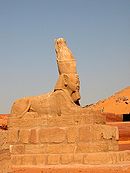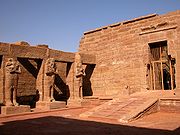
Wadi es-Sebua
Encyclopedia

Arabic language
Arabic is a name applied to the descendants of the Classical Arabic language of the 6th century AD, used most prominently in the Quran, the Islamic Holy Book...
: واديالسبوع), is the site of two New Kingdom Egyptian temple
Egyptian temple
Egyptian temples were built for the official worship of the gods and commemoration of pharaohs in Ancient Egypt and in regions under Egyptian control. These temples were seen as houses for the gods or kings to whom they were dedicated...
s, including one impressively large temple spéos of Ramesses II, at the edge of Nasser lake in Lower Nubia. The first temple was built by Amenhotep III
Amenhotep III
Amenhotep III also known as Amenhotep the Magnificent was the ninth pharaoh of the Eighteenth dynasty. According to different authors, he ruled Egypt from June 1386 to 1349 BC or June 1388 BC to December 1351 BC/1350 BC after his father Thutmose IV died...
and subsequently restored by Ramesses II
Ramesses II
Ramesses II , referred to as Ramesses the Great, was the third Egyptian pharaoh of the Nineteenth dynasty. He is often regarded as the greatest, most celebrated, and most powerful pharaoh of the Egyptian Empire...
. In its first stage, this temple "consisted of a rock-cut sanctuary (about 3 m by 2 m) fronted by a brick-built pylon, a court and a hall, partly painted with wall paintings." The temple was perhaps dedicated to one of the local Nubian forms of Horus
Horus
Horus is one of the oldest and most significant deities in the Ancient Egyptian religion, who was worshipped from at least the late Predynastic period through to Greco-Roman times. Different forms of Horus are recorded in history and these are treated as distinct gods by Egyptologists...
, but his representations were altered to Amun at a later point in time. During the Amarna
Amarna
Amarna is an extensive Egyptian archaeological site that represents the remains of the capital city newly–established and built by the Pharaoh Akhenaten of the late Eighteenth Dynasty , and abandoned shortly afterwards...
period, images of Amun were attacked and the decorations deteriorated but Ramesses II later restored and extended Amenhotep III's temple by building structures in front of the pylon.
The temple of Amun of Ramesses II



Kingdom of Kush
The native name of the Kingdom was likely kaš, recorded in Egyptian as .The name Kash is probably connected to Cush in the Hebrew Bible , son of Ham ....
, Setau
Setau
Setau was the Viceroy of Kush in the second half of Ramesses II's reign. Contemporary records show that Setau served in this position from Year 38 until at least Year 63 of Ramesses II's reign. Setau was "a graduate of the royal school" and already enjoyed an impressive record of royal service...
, indicate that this temple was set up between Years 35 and Year 50 of Ramesses II. Setau is known to have served as the Viceroy of Kush or Nubia between Year 38 to 63 of this pharaoh's reign and was responsible for Ramesses' later Nubian temples. The temple of Wadi es-Sebua was the third sanctuary or chapel constructed from rock with a forecourt built with stones that Ramesses II erected in Nubia. Located at approximately a hundred and fifty kilometers south of Aswan, on the western bank of the Nile, the temple owed its importance to the fact that during the Ramesside period, the city was built at the outlet of the caravan roads, was used as the place of residence for the viceroy of Kush and because it was located at a difficult stretch of the Nile which was difficult for boats to traverse up against the current. Ramesses II entrusted the management of his work projects here to the viceroy of Nubia Setau which, if one judges by the poor quality of the Osiride style and statues of the court, was forced to settle on an "untrained work force, many of whom were snatched from the Libyan oases" and by "inferior raw materials."
The temple of "Ramesses beloved of Amon in the field of Amun" was used as a quay or resting place for boats during its descent of the Nile river. The local Arabs, inspired by the stone sculptures of sphinxes which lined the entrance to the first temple, baptized the place as 'Wadi es-Sebua' or the Valley of the lions. The temple comprised three distinct parts: two open courts which were decorated with sphinxes or dromos, a large interior court with Osiride pillars and the rock hewn temple. This temple was, hence, "partly free-standing and partly rock-cut."
The temple once possessed three pylons. The first two, however, were made of inferior Nile mud brick and have since crumbled. Only the stone gate passageway through them has survived. Beyond the first tower, the first courtyard appears with two human headed sphinxes accompanied by two statues of the pharaoh himself which originally stand on both sides of the passageway. Only the left-hand statue of Ramesses II remains in situ whereas the other statue now lies in the desert. Beyond the second pylon, a second courtyard with four falconheaded sphinxes appear representing Horus of Miam, of Meha, of Baki and, curiously, Horus of Edfu when one would expect that of Buhen instead in Nubia. Between their legs, a statuette with the image of Ramesses capped with the némès crown appears. On their base, an inscription states Ramesses "Lord of Sed-festivals, as his/her Ptah father" refers to the desire for longevity on behalf of this pharaoh which was already expressed on the vestiges of the second door: "Ramsès-Meryamun, lord of Sed-festivals, like Ptah." Just prior to entering the third tower, four colossal statues of Ramesses II appear of which, only one statue remains upright today. The third pylon is decorated with the conventional Egyptian style of the Pharaoh smiting his enemies and making offerings to the gods, including himself. Once one passes through the third pylon, the rock cut section of the temple begins with a hypostyle hall composed of 12 square pillars:
- "of which the central six were once adorned with Osirid statues of the king; these were chiselled off by the Christians. However, the offering scenes on the walls survive, and some retain their [original] colour."
The "antechamber opens into two side rooms, two side chapels and the sanctuary itself." Although the statues in the sanctuary niches were destroyed, they "undoubtedly represented Amon-Re, Re-Harakhty and Ramesses II himself." The larger temple at Wadi es-Sebua was built in the rather rough Nubian style, which marked some of Ramesses II's larger buildings.
Development into a church
In the 5th century AD, the temple was converted into a Christian church. Some temple reliefs were covered with a layer of plaster, where painted images of God was done. This layer helped to preserve for posterity the original reliefs; the best examples here are located in the sanctuary and associated chapels of Ramesses' temple where colourful scenes depict Ramesess adoring the sacred boats of Amun-Re and Re-Horakhty. There is also an interesting scene in the central niche of Wadi es-Sebua temple where two statues of Amun and Re-Horakhty which stood besides Ramesses II were hacked away by later Christian worshippers and replaced by an image of St. Peter. When the plaster coating was removed from the carved reliefs, one finds a bizarre image of Ramesses II offering flowers to...St Peter instead.Relocation of the Temple
When the Wadi es-Sebua temples were threatened by flooding from the construction of the Aswan Dam project, the temple was dismantled in 1964 with U.S. support by the Egyptian Antiquities Service. They were moved to a new site only 4 km west from their original location.The Temple of Dakka
Temple of Dakka
Ad-Dakka was a place in Lower Nubia, which was located approximately 100 km south of the Aswan...
and Temple of Maharraqa
Temple of Maharraqa
Al-Maharraqa is a place in Lower Nubia, which was approximately 120 km south of Aswan on the southern border of the Roman empire. Only a few years after the Roman conquest of Egypt in 30 BC, the Kushites from the kingdom of Meroë launched a raid on the First cataract region of Egypt in 23 BC...
were also moved and rebuilt at the new Wadi es-Sebua temple complex area.
External links
- The Temple of Wadi al-Sabua in Nubia
- The excavations and survey between Wadi es-Sebua and Adindan, 1929-1931 by W.B. Emery & L.P. Kirwan

